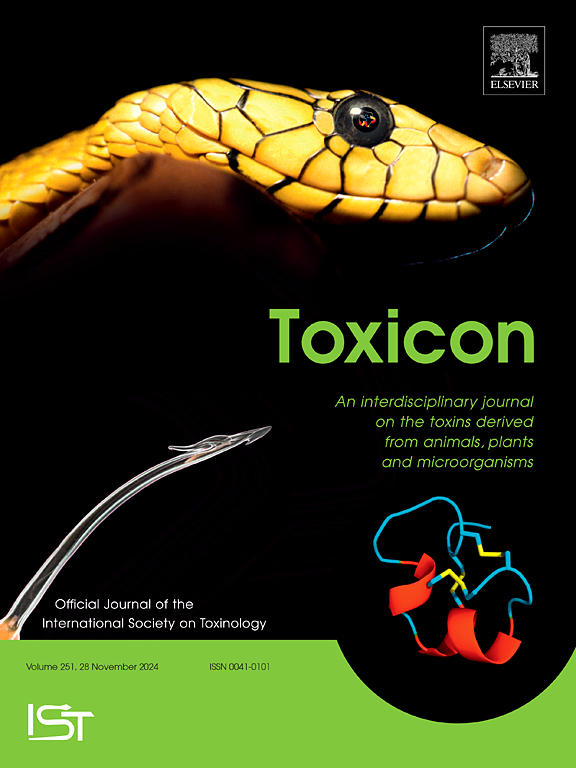兔兔(无尾目:蟾科)皮肤分泌的蛋白质组学和肽组学特征
IF 2.6
4区 医学
Q2 PHARMACOLOGY & PHARMACY
引用次数: 0
摘要
古特蛙(Rhaebo guttatus)是蟾蜍科的一种南美青蛙。其抵御天敌的能力主要归功于类固醇、生物碱和生物胺等小分子物质。然而,目前还缺乏对其毒液中蛋白质和肽的研究。本研究旨在分析这些生物大分子并研究其生物学意义。我们利用纳米液相色谱-高分辨质谱(nanoLC-ESI-q-ToF)技术进行了霰弹枪蛋白质组学和肽组学分析。古特兰蛙的蛋白质组特征与其他蛙类相似,包括与肌肉收缩相关的蛋白质、参与氧化应激的酶--可能反映了皮肤持续暴露于太阳辐射和活性氧物种的情况--以及免疫相关的蛋白质,如 galectin 和 annexin。正如之前的研究表明的那样,这些蛋白质似乎在维持两栖动物体内平衡方面发挥了作用。肽组分析表明,一些天然肽可能来自毒液分泌物中蛋白质的降解。有趣的是,在肽组学中发现的某些类别的蛋白质在蛋白质组数据集中没有检测到,这突出表明了这些全息方法在揭示毒液分子多样性方面的互补性。在鉴定出的多肽中,我们认为有些来自 BASP1,这是一种通常与大脑相关的蛋白质。在这种情况下,我们假设这些肽源于神经肌肉接头,可能参与轴突再生和突触发生过程。BASP1 还被认为是各种肿瘤的转录抑制因子,这表明它具有潜在的药理应用价值。此外,研究人员还发现了几种 ALC >90 % 的新肽。包括预测和分子建模在内的硅学分析表明,其中一些肽具有抗菌活性,为今后开展生物技术和治疗方面的研究铺平了道路。本文章由计算机程序翻译,如有差异,请以英文原文为准。

Proteomic and peptidomic characterization of Rhaebo guttatus (Anura: Bufonidae) skin secretion
Rhaebo guttatus is a South American frog species from the Bufonidae family. Its defense against predators is primarily attributed to small molecules such as steroids, alkaloids, and biogenic amines. However, there is a lack of studies focusing on the proteins and peptides in its venom. This study aimed to analyze these biomolecules and investigate their biological significance. Using nano liquid chromatography coupled to high-resolution mass spectrometry (nanoLC-ESI-q-ToF), we performed shotgun proteomics and peptidomics analyses. The proteomic profile of R. guttatus showed similarities to those of other frog species, including proteins associated with muscle contraction, enzymes involved in oxidative stress—likely reflecting the skin's constant exposure to solar radiation and reactive oxygen species—and immune-related proteins such as galectin and annexin. These proteins appear to play a role in maintaining amphibian homeostasis, as suggested by previous studies. Peptidomic analysis revealed that some natural peptides may originate from the degradation of proteins present in the venom secretion. Interestingly, certain classes of proteins identified in the peptidomics were not detected in the proteomic dataset, underscoring the complementary nature of these omics approaches for unraveling venom molecular diversity. Among the peptides identified, we propose that some derive from BASP1, a protein typically associated with the brain. In this context, we hypothesize that these peptides originate from neuromuscular junctions and may participate in axonal regeneration and synaptogenesis processes. BASP1 is also recognized as a transcriptional suppressor of various tumors, suggesting potential pharmacological applications. Additionally, several de novo peptides with ALC >90 % were identified. In silico analyses, including prediction and molecular modeling, suggested antimicrobial activity for some of these peptides, paving the way for future studies with biotechnological and therapeutic interests.
求助全文
通过发布文献求助,成功后即可免费获取论文全文。
去求助
来源期刊

Toxicon
医学-毒理学
CiteScore
4.80
自引率
10.70%
发文量
358
审稿时长
68 days
期刊介绍:
Toxicon has an open access mirror Toxicon: X, sharing the same aims and scope, editorial team, submission system and rigorous peer review. An introductory offer Toxicon: X - full waiver of the Open Access fee.
Toxicon''s "aims and scope" are to publish:
-articles containing the results of original research on problems related to toxins derived from animals, plants and microorganisms
-papers on novel findings related to the chemical, pharmacological, toxicological, and immunological properties of natural toxins
-molecular biological studies of toxins and other genes from poisonous and venomous organisms that advance understanding of the role or function of toxins
-clinical observations on poisoning and envenoming where a new therapeutic principle has been proposed or a decidedly superior clinical result has been obtained.
-material on the use of toxins as tools in studying biological processes and material on subjects related to venom and antivenom problems.
-articles on the translational application of toxins, for example as drugs and insecticides
-epidemiological studies on envenoming or poisoning, so long as they highlight a previously unrecognised medical problem or provide insight into the prevention or medical treatment of envenoming or poisoning. Retrospective surveys of hospital records, especially those lacking species identification, will not be considered for publication. Properly designed prospective community-based surveys are strongly encouraged.
-articles describing well-known activities of venoms, such as antibacterial, anticancer, and analgesic activities of arachnid venoms, without any attempt to define the mechanism of action or purify the active component, will not be considered for publication in Toxicon.
-review articles on problems related to toxinology.
To encourage the exchange of ideas, sections of the journal may be devoted to Short Communications, Letters to the Editor and activities of the affiliated societies.
 求助内容:
求助内容: 应助结果提醒方式:
应助结果提醒方式:


